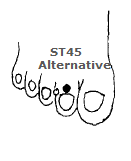- HOME »
- Meridians »
- Stomach Meridian(ST)
Stomach Meridian(ST) for Acupuncture and Moxabustion
Stomach Meridian(ST) 足陽明胃経
◐ ST-1 承泣 ◐ ST-2 四白 ◐ ST-3 巨髎 ◐ ST-4 地倉 ◐ ST-5 大迎 ◐ ST-6 頰車 ◐ ST-7 下関 ◐ ST-8 頭維 ◐ ST-9 人迎 ◐ ST-10 水突 ◐ ST-11 気舎 ◐ ST-12 缺盆 ◐ ST-13 気戸 ◐ ST-14 庫房 ◐ ST-15 屋翳 ◐ ST-16 膺窓 ◐ ST-17 乳中 ◐ ST-18 乳根 ◐ ST-19 不容 ◐ ST-20 承満 ◐ ST-21 梁門 ◐ ST-22 関門 ◐ ST-23 太乙 ◐ ST-24 滑肉門 ◐ ST-25 天枢 ◐ ST-26 外陵 ◐ ST-27 大巨 ◐ ST-28 水道 ◐ ST-29 帰来 ◐ ST-30 気衝 ◐ ST-31 髀関 ◐ ST-32 伏兎 ◐ ST-33 陰市 ◐ ST-34 梁丘 ◐ ST-35 犢鼻 ◐ ST-36 足三里 ◐ ST-37 上巨虚 ◐ ST-38 条口 ◐ ST-39 下巨虚 ◐ ST-40 豊隆 ◐ ST-41 解谿 ◐ ST-42 衝陽 ◐ ST-43 陷谷 ◐ ST-44 内庭 ◐ ST-45 厲兌

ST-1 承泣


WHO : On the face, between the eyeball and the
infraorbital margin, directly inferior to the
pupil.
Use for : Eye diseases and problems. Lacrimation. Sensitivity to glare, This point can use for bloodletting
ST-2 四白
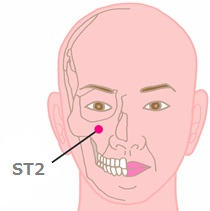

WHO : On the face, in the infraorbital foramen.
Use for : Eye diseases and problems, Upper toothache, Periodontitis, Sinusitis, Speech disorders
ST-3 巨髎

WHO : On the face, directly inferior to the pupil, at the same level as the inferior border of the ala of the nose.
Note: When looking straight ahead, ST3 is located at the intersection of the vertical line of the pupil and the horizontal line of the inferior border of the ala of the nose.
Use for : Eye diseases and problems, Upper toothache, Sinusitis, Trigeminal neuralgia, Facial nerve paralysis
ST-4 地倉

WHO : On the face, 0.4 F-cun lateral to the angle of the mouth.
Note: Lateral to the angle of the mouth, the point is located in the nasolabial sulcus or on the continuation of the nasolabial sulcus.
Use for : Facial nerve paralysis, Trigeminal nerve paralysis
ST-5 大迎

WHO : On the face, anterior to the angle of the mandible, in the depression anterior to the masseter attachment, over the facial artery.
Use for : Lower toothache, Periodontitis, Facial nerve paralysis, Trigeminal nerve paralysis
ST-6 頰車


WHO : On the face, one fingerbreadth (middle finger) anterosuperior to the angle of the mandible.
Note: On the bisector of the angle of the mandible. When the mouth is closed and the teeth are clenched, this point is located at the prominence of the masseter and in the depression felt when the clenched teeth are released.
Practical : Open the mouth and find a depression appears between the ear lobe and mandible corner.
ST-7 下関

WHO : On the face, in the depression between the midpoint of the inferior border of the zygomatic arch and the mandibular notch.
Note: When the mouth is closed, ST7 is located at the depression inferior to the zygomatic arch, directly inferior to GB3.
Practical : 2 fingers from the ear, the depression in the middle of the zygomatic arch.
Use for : Periodontitis, Facial nerve paralysis, Trigeminal nerve paralysis
ST-8 頭維
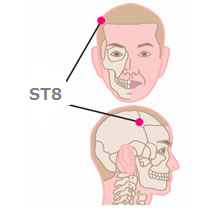
WHO : On the head, 0.5 B-cun directly superior to the anterior hairline at the corner of the forehead, 4.5 B-cun lateral to the anterior median line.
Use for : Low vision, Excessive lacrimation, Migraine, Trigeminal neuralgia
ST-9 人迎


WHO : In the anterior region of the neck, at the same level as the superior border of the thyroid cartilage, anterior to the sternocleidomastoid muscle, over the common carotid artery.
Note 1: The sternocleidomastoid muscle is more distinct when the head is turned to the opposite side against resistance.
Note 2: ST9 is located at the same level as LI18, SI16 and the superior border of the thyroid cartilage. ST9 is located anterior to the sternocleidomastoid muscle, and SI16, posterior to the sternocleidomastoid muscle and LI18, between the anterior and posterior borders of the sternocleidomastoid muscle.
Practical : This is the point for taking a pulse, checking for yin-yang condition of 5臓.
Use for : Asthma, Bronchitis, Basedow’s disease, Hypertension
ST-10 水突


WHO : In the anterior region of the neck, at the same level as the cricoid cartilage, just anterior to the border of the sternocleidomastoid muscle.
Use for : Throat problems and diseases, Bronchitis, Tonsillitis
ST-11 気舎

WHO : In the anterior region of the neck, in the lesser supraclavicular fossa, superior to the sternal end of the clavicle, in the depression between the sternal and clavicular heads of the sternocleidomastoid muscle.
Note 1: The sternocleidomastoid muscle is more distinct when the head is turned to the opposite side against resistance.
Note 2: ST11 is located superior to the clavicle, inferior to ST9.
Use for : Frozen shoulder, Throat problems and diseases, Bronchitis, Torticollis
ST-12 缺盆

WHO : In the anterior region of the neck, in the greater supraclavicular fossa, 4 B-cun lateral to the anterior median line, in the depression superior to the clavicle.
Use for : Frozen shoulder, Pleurisy, Bronchitis, Neuralgia in arms
ST-13 気戸


WHO : In the anterior thoracic region, inferior to the clavicle, 4 B-cun lateral to the anterior median line.
Use for :
ST-14 庫房
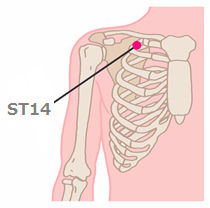
WHO : In the anterior thoracic region, in the first intercostal space, 4 B-cun lateral to the anterior median line.
Use for : Respiratory disease, Heart disease, Hot flashes, Dyspnea, Phlegm
ST-15 屋翳

WHO : n the anterior thoracic region, in the second intercostal space, 4 B-cun lateral to the anterior median line.
Note: The second intercostal space is inferior to the second rib which is located at the same level as the sternal angle.
Use for : Respiratory disease, Heart disease, Intercostal neuralgia
ST-16 膺窓

WHO : In the anterior thoracic region, in the third intercostal space, 4 B-cun lateral to the anterior median line.
Use for : Mastitis
ST-17 乳中
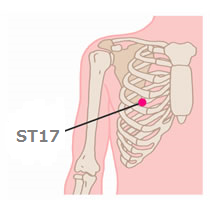
WHO : In the anterior thoracic region, at the centre of the nipple.
Note: In males, the centre of the nipple is located in the fourth intercostal space.
Use for : Never use
ST-18 乳根
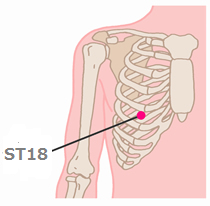
WHO : In the anterior thoracic region, in the fifth intercostal space, 4 B-cun lateral to the anterior median line.
Note: In males, ST18 is located at the intersection of nipple line and the fifth intercostal space. In females, ST18 is located at the midpoint of the inferior crease of the breast.
Use for : Intercostal neuralgia, Pleurisy, Mastitis(don’t use when swelling), Hiccup
ST-19 不容

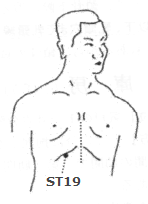
WHO : On the upper abdomen, 6 B-cun superior to the centre of the umbilicus, 2 B-cun lateral to the anterior median line.
Note 1: ST 19 is 2 B-cun lateral to CV14.
Note 2: If the infrasternal angle is too sharp and the rib is located inferior to ST19, ST19 can be reached by oblique needling.
Use for : Stomach pain, Stomach cramps, Gastric atony, Diaphragm spasms, Pleurisy, Hiccup, Cough, Asthma, Hyperacidity
ST-20 承満


WHO : On the upper abdomen, 5 B-cun superior to the centre of the umbilicus, 2 B-cun lateral to the anterior median line.
Note: ST20 is 5 B-cun superior to ST25, 1 B-cun inferior to ST19, 2 B-cun lateral to CV13.
Use for : Abdominal distension, Hyperventilation, Dyspnea, Stifling, Excessive appetite
ST-21 梁門

WHO : On the upper abdomen, 4 B-cun superior to the centre of the umbilicus, 2 B-cun lateral to the anterior median line.
Note: ST21 is 4 B-cun superior to ST25, 1 B-cun inferior to ST20, 2 B-cun lateral to CV12.
Use for : Gastric disease(with BL21 + BL20 + CV12) , Bowel disease, Hemorrhoid, In the case of gastric cancer, the lump appears in this point.
ST-22 関門


WHO : On the upper abdomen, 3 B-cun superior to the centre of the umbilicus, 2 B-cun lateral to the anterior median line.
Note: ST22 is located at the same level and lateral to KI18 and CV11.
Use for : Same as ST21, Enuresis
ST-23 太乙

WHO : On the upper abdomen, 2 B-cun superior to the centre of the umbilicus, 2 B-cun lateral to the anterior median line.
Note: ST23 is located at the same level and lateral to KI17 and CV10.
Use for : Gastrointestinal disease, Enuresis
ST-24 滑肉門

WHO : On the upper abdomen, 1 B-cun superior to the centre of the umbilicus, 2 B-cun lateral to the anterior median line.
Note: ST24 is at the same level and lateral to CV9.
Use for : Nephritis, Pyelitis, Dyspepsia, Otitis media, Tinnitus
*別名=司天の穴:人身における臍以上の病の現れるところ
ST-25 天枢

WHO : On the upper abdomen, 2 B-cun lateral to the centre of the umbilicus.
Practical : 3 fingers from naval.
Use for : Large intestine problems, Diarrhea, Constipation, Genital disease, Leukorrhea, Dyspepsia, Pale, Regulating intestinal function
ST-26 外陵


WHO : On the lower abdomen, 1 B-cun inferior to the centre of the umbilicus, 2 B-cun lateral to the anterior median line.
Note: ST26 is at the same level and lateral to KI15 and CV7.
Practical : One thumb from ST25, 3 fingers from CV7.
Use for : Abdominal pains, Constipation
ST-27 大巨

WHO : On the lower abdomen, 2 B-cun inferior to the centre of the umbilicus, 2 B-cun lateral to the anterior median line.
Note: ST27 is at the same level and lateral to KI14 and CV5.
Practical : 3 fingers from ST25, 3 fingers from CV5.
Use for : Intestinal colic, Constipation
ST-28 水道

WHO : On the lower abdomen, 3 B-cun inferior to the centre of the umbilicus, 2 B-cun lateral to the anterior median line.
Note: ST28 is 3 B-cun inferior to ST25, 1 B-cun inferior to ST27, 2 B-cun lateral to CV4.
Practical : 4 fingers from ST25, 3 fingers from CV4.
Use for : Kidney disease, Bladder disease, Uterus disease
ST-29 帰来

WHO : On the lower abdomen, 4 B-cun inferior to the centre of the umbilicus, 2 B-cun lateral to the anterior median line.
Note: ST29 is 4 B-cun inferior to ST25, 1 B-cun inferior to ST28, 2 B-cun lateral to CV3.
Use for : Genitourinary disorder, Kidney, Urethritis, Endometritis, Irregular menstruation, Impotence, Nocturnal emission
ST-30 気衝


WHO : In the groin region, at the same level as the superior border of the pubic symphysis, 2 B-cun lateral to the anterior median line, over the femoral artery.
Note: ST30 is 5 B-cun inferior to ST25, 2 B-cun lateral to CV2.
Practical : Put a thumb on the pelvis, the point where the middle finger tip, can feel pulse.
Use for : Salpingitis, Oophoritis, Endometritis, Epididymitis, Prostatitis, Cystitis, Pyelitis
ST-31 髀関

WHO : On the anterior aspect of the thigh, in the depression among three muscles: the proximal portion of the rectus femoris muscle, the sartorius muscle and the tensor fasciae latae muscle.
Note 1: With the hip and the knee in slight flexion, and the thigh slightly abducted when resistance is placed against the anteromedial aspect of the thigh, a triangular depression appears. The proximal portion of the rectus femoris muscle is found in the depression between the sartorius muscle medially and the tensor fascia latae muscle laterally. ST31 is located at the deepest point in the depression inferior to the apex of this triangle.
Note 2: ST31 is located at the intersection of the line connecting the lateral end of the base of the patella with the anterior superior iliac spine, and the horizontal line of the inferior border of the pubic symphysis.
Use for : Intestinal colic, Convulsions and inability bending and stretching of the thigh, Palsy, Partial paralysis
ST-32 伏兎

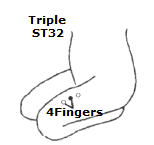
WHO : On the anterolateral aspect of the thigh, on the line connecting the lateral end of the base of the patella with the anterior superior iliac spine, 6 B-cun superior to the base of the patella.
Practical : Middle point of outside upper corner of Patella and ST-31
Use for : Sciatica, Frigidity(include 2 points ;
4fingers from ST-32 both side up and down called 伏兎三点(triple ST-32), most likely pain or sensation appear with frigidity person and can use for this 3 points for frigidity)
ST-33 陰市


WHO : On the anterolateral aspect of the thigh, lateral to the rectus femoris tendon, 3 B-cun superior to the base of the patella.
Note: ST33 is at the midpoint of the line connecting ST32 with the lateral end of the base of the patella.
Practical : Bend the knee like vajrasana position, 4fingers up from outside upper corner of Patella. 3fingers up would be ST-34
Use for : Lower abdominal pain, Knee, Neuralgia of the lower limbs(with GB31), 腹、腰、下半身の冷え
ST-34 梁丘


WHO : On the anterolateral aspect of the thigh, between the vastus lateralis muscle and the lateral border of the rectus femoris tendon, 2 B-cun superior to the base of the patella.
Note: Putting the thigh muscle under tension, the rectus femoris tendon and the vastus lateralis muscle are more distinct. ST34 is located between the muscle and the tendon, 1 B-cun directly inferior to ST33.
Practical : Bend the knee and place a thumb in the depression of outer inferior patella, find this point by index finger.
Use for : Abdominal pain, Stomach cramps, Diarrhea
ST-35 犢鼻

WHO : On the anterior aspect of the knee, in the depression lateral to the patellar ligament.
Note: When the knee is flexed, ST35 is located in the depression lateral and inferior to the patella.
Use for : Beriberi, Knee(膝眼四穴)
ST-36 足三里

WHO : On the anterior aspect of the leg, on the line connecting ST35 with ST41, 3 B-cun inferior to ST35.
Note: ST36 is located on the tibialis anterior muscle.
Practical : Slide up the front edge of tibia by index finger. The finger would be automatically stop. From here, get a point one thumb size outside of tibia.
Use for : Any kind of chronic disease, Palsy, Partial paralysis, Rhinitis, Gastrointestinal disease(not for hyperacidity), Lack of vital energy, Abdominal pain, Beriberi, Blurred vision, Body weakness, Nervous breakdown, Hysteria, Balancing the Autonomic Nervous System
ST-37 上巨虚


WHO : On the anterior aspect of the leg, on the line connecting ST35 with ST41, 6 B-cun inferior to ST35.
Note: ST37 is located on the tibialis anterior muscle.
Practical : 4 fingers down from ST36.
Use for : Enteritis, Diarrhea, Constipation, Partial paralysis, Beriberi
ST-38 条口

WHO : On the anterior aspect of the leg, on the line connecting ST35 with ST41, 8 B-cun inferior to ST35.
Note: ST38 is located on the tibialis anterior muscle, at the same level as ST40.
Practical : 3 fingers down from ST37.
Use for : Gastrointestinal weakness, Knee arthritis, Cold feet
ST-39 下巨虚

WHO : On the anterior aspect of the leg, on the line connecting ST35 with ST41, 9 B-cun inferior to ST35.
Note: ST39 is located on the tibialis anterior muscle, at the same level as GB35 and GB36.
Practical : 4 fingers X 2(8fingers size) down from ST36.
Use for : Intestinal colic, Leg paralysis, Infantile paralysis
ST-40 豊隆

WHO : On the anterolateral aspect of the leg, lateral border of the tibialis anterior muscle, 8 B-cun superior to the prominence of the lateral malleolus.
Note: ST40 is one fingerbreadth (middle finger) lateral to ST38.
Practical : One thumb outside from ST38.
Use for : Neurasthenie, Hysteria, Epilepsy, Bowel pain, Colic, Constipation, Excretion difficulty of urine and feces, Body feel heavy and dizzy with neuralgia in legs, Difficulty bending the knee
ST-41 解谿


WHO : On the anterior aspect of the ankle, in the depression at the centre of the front surface of the ankle joint, between the tendons of extensor hallucis longus and extensor digitorum longus.
Note: ST41 is located between two tendons on the dorsum of the foot which are more distinct when the ankle is in dorsiflexion, and is at the midpoint of the line connecting the prominences of the lateral malleolus and the medial malleolus.
Use for : Foot arthritis, Rheumatism, Sprained ankle, Upper eyelid drooping, Hot flashes, Asthma, Cough, Floater
ST-42 衝陽

WHO : On the dorsum of the foot, at the joint of the base of the second metatarsal bone and the intermediate cuneiform bone, over the dorsalis pedis artery.
Use for : Blurred vision
ST-43 陷谷

WHO : On the dorsum of the foot, between the second and third metatarsal bones, in the depression proximal to the second metatarsophalangeal joint.
Use for : Abdominal pain, Facial edema
ST-44 内庭


WHO : On the dorsum of the foot, between the second and third toes, posterior to the web margin, at the border between the red and white flesh.
Practical : ReversedST44 : 足の第2趾の趾頭の中央に墨で仮点を付け、趾を折り曲げたときに、足底に墨のついたところが裏内庭.
ReversedST44 use for : Food poisoning, Gastric disease, Hives
ST-45 厲兌

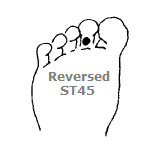
WHO : On the second toe, lateral to the distal phalanx, 0.1 F-cun proximal-lateral to the lateral corner of the second toenail, at the intersection of the vertical line of the lateral border and the horizontal line of the base of the second toenail.
Practical : AlternativeST45 中厲兌 = On the second toe, middle point of thin skin of nail.
AlternativeST45 use for : Motion sickness, Dizziness with low blood pressure, Nasal catarrh, Tonsillitis, Cerebral anemia, Diabetes, Facial paralysis, Jaundice
